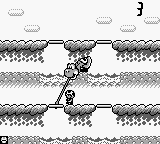Overview

Game & Watch Gallery (known in Japan as Game Boy Gallery and in Australia as Game Boy Gallery 2) is a mini-game collection developed and published by Nintendo for the Game Boy on February 1997 in Japan, on May 1997 in North America, and sometime in 1997 in Europe and Australia.
A successor to the limited-release 1994 Game Boy game Game Boy Gallery, Game & Watch Gallery includes digital adaptations of four games from Nintendo's Game & Watch series of handheld electronic games: Manhole, Fire, Octopus, and Oil Panic.
Along with near-authentic recreations in each game's "Classic" mode, the collection includes an updated "Modern" version of each game, which make significant gameplay changes while adding characters from Nintendo's mainline Mario series. The game itself also includes enhanced Super Game Boy support (with a larger color palette and custom backgrounds), an "Interrupt Save" feature that allows players to save their current game state and return to it later, and an unlockable gallery (showcasing games from the Game & Watch line).
The game later received a sequel, known as Game & Watch Gallery 2. The modern versions of Fire and Octopus were later recreated in Game & Watch Gallery 4. The game also received a digital re-release for the Nintendo 3DS (as a Virtual Console title) on June-July 2011.
Games
Manhole

In Manhole, players must move between four spots (two in the foreground and two in the background) and hold up manhole covers to allow other pedestrians to pass through open manholes without falling into the waterway below.
In the Modern version, the player character is Yoshi, who stands in one spot and uses his tongue and snout to keep all four manholes up for the roaming Toads, Donkey Kong Jr.'s, and Marios. Unlike in Classic Mode, the manhole covers are kept up, but can be knocked down once stepped on (forcing Yoshi to either hold them as they're being stepped on, or take time to pull them back up).
Fire

In Fire, players must guide a team with a stretcher to trampoline people between a burning building and an ambulance, moving between three positions without having any person hit the ground below.
In the Modern version, the player characters are the Mario Bros., who must trampoline Toads, Donkey Kong Jr.'s, and Yoshis between a burning castle and a carriage. Unlike in Classic Mode, each falling character has different speeds and falling patterns, and optional Yoshi Eggs can break open into Starmen (for extra points) or Bob-ombs (which have to be left to hit the ground).
Octopus
In Octopus, players must guide their scuba diver past a giant octopus to retrieve as much sunken treasure as they can, getting points both for putting treasure in their bag and for dispensing their collected treasure back on the boat. The game follows a set five-point path through the water, each guarded by one of the octopus's appendages (which move in-and-out and must be avoided).
In the Modern version, the player character is a scuba-diving Mario. Unlike in Classic Mode, collecting more treasure at once causes Mario to move slower, and players can choose to throw their treasure pouch at an appendage to stun the octopus.
Oil Panic
In Oil Panic, players must move their character back-and-forth in the higher floor of a gas station, catching oil drops from a leaky ceiling pipe with their bucket. As they don't want their bucket to overflow, they must frequently dump it out at the sides of the building to their comrade below that is carrying a barrel. As the barrel carrier automatically moves back-and-forth, players have to be careful not to accidentally dump the oil into pedestrians on the street. Players move between five spots: three where a drop would land and one for each side.
It is the collection's sole split-screen game and, to make it neatly fit the squared Game Boy screen, shrinks the top screen down to a smaller size. One unique feature of the game is its lives system, which only ends the game if the player messes up three times on the top screen (failing to catch oil properly) or three times on the bottom screen (failing to dump the oil properly).
In the Modern version, the player character is Mario, who must catch scorching oil dripped through the roof by Bowser and dump them to Yoshi (who ingests it to breathe fire). Unlike in Classic Mode, Mario carries a bucket in each hand, which allows him to move between two inward spots rather than three (with a new button used to pivot himself in-place). In addition, ingesting a large amount of oil at once can cause Yoshi to reveal blocks, which can be used to grant bonus points.
Log in to comment